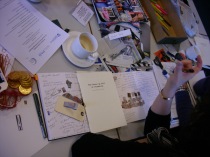As the people who have come to my workshops know, I have gotten into the habit of making and giving out little booklets. I call them ‘tactile academia books’ (which sounds a bit grand), and I thought it was high time to post a few details about them.
I thought I would start with The Land- and Seascape of Creative Practice. This wasn’t the first one I did, but it was based on an idea that I had a long time ago and on a concept I have been using to explain what I do for quite some time. And in a way it explains my take on academic and creative practice – and the relationship between them.
So here the little story behind this book…
When I started teaching at uni, I joined an Art & Design department as an academic looking after the first year study skills provision. Very much a Writing in the Disciplines approach, I was tasked with running modules that would teach studio-based art, design and media students how to research and write for an academic essay. And I found myself quite often in the position of having to explain to other colleagues how what I did fit into the individual programmes, and how it did work that my students ranged from 3D Design to Animation, from Fine Art to Film Production.

Art, Design and Media Islands in my teaching ca 2008/09
What I started using was the image of islands, each representing a separate discipline, but each connected in a way through an ocean, that could be seen as ‘Contextual Studies’ (the historical and theoretical stuff that is somehow outside of the making).
While it is, like any visual analogy, a fairly simplified model, I think this shows the relationship between the realm of the tangible outcome, the islands, on the one hand, and the more theoretical thinking, the ocean, on the other. (The Study Skills bit I always thought of as somewhere in the shallows around the islands, linking the practical and the theoretical approach to a specific discipline.) It also made me think about the ntaure of words as an outcome, which can be a bit like water: they can be shallow or deep, they can be watered down, but above all they are fluid.
This image stayed with me and when I encountered Artist’s Books and thought I might be interested in making some myself, I used this as the starting point of my first foray into screen printing, making an accordion fold book called Contours.

Contours 2011
The idea was that it would show a part of that initial map idea, but visualise the thinking in more detail. So the island bit used images – pictures of finished artefacts inland, then images of word in progress, maquettes, and finally sketches where it came to the ‘beach’ – while the ocean bit used words – hand-written notes in the shallows, then artists statements and more and more theoretical (and later on abstract) texts on craft.
While Contours is a plan view, I always wanted to make a sort of elevation, because that would visualise the idea of shallows and depth more. It took me a while to find the right technique, but last year I was on a printing course where we made scratch negatives, which can result in printing plates, which are very fine and detailed, almost like engravings, and here I was able to make this image, which I think shows the land- and seascape of creative practice.

The Land- and Seascape of Academic Practice 2012
a tactile Academia book
This print has become the centrepiece of this particular booklet, The Land- and Seascape of Creative Practice. Subtitled ‘Modelling Knowledge’ it aims to explain the relationship between creative practice and theoretical thinking – and does so by not just introducing the islands analogy, but also mapping Donald Schon’s notion of reflective practice and Michael Biggs’ differentiation of experiential feeling and experiential knowledge onto it. it aims to make the point that there is a synergy between the making and the theory – and that it is useful (if not crucial) to be able to engage with both for the best results in either.
The booklet itself was made in an edition of 73 and given out to participants of the second day of the Teaching in Practice event. All of the copies include an original print of the map artwork. (And I still have some copies, so if you would like a copy, get in touch!)


































